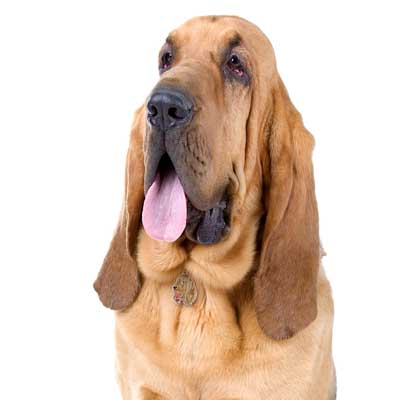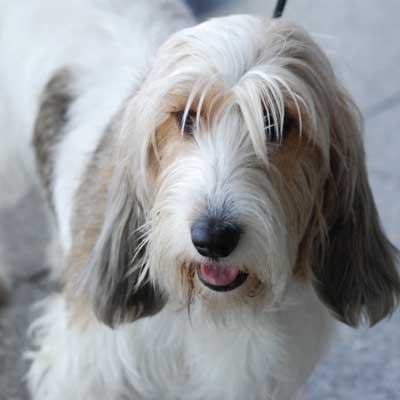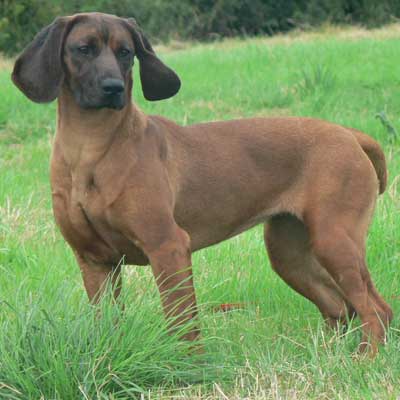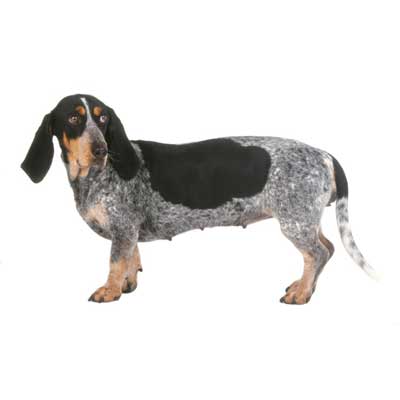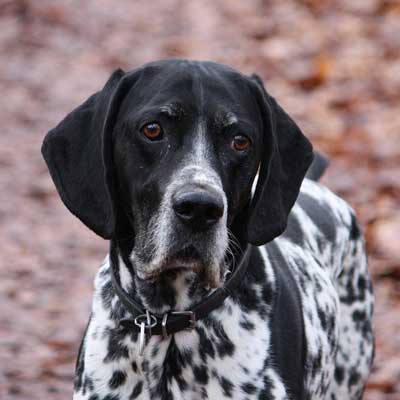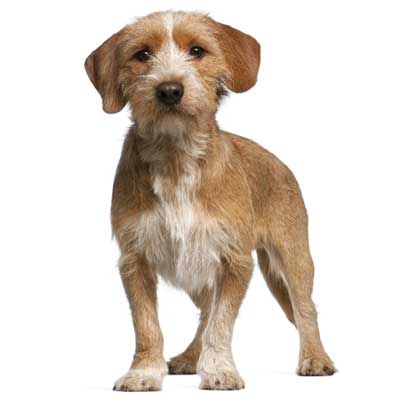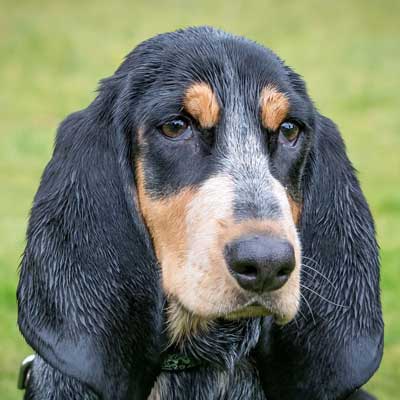Bloodhound Chien De Saint-Hubert
Apprezzato per il fiuto, è un cane socievole e mite con tutti
-
Testa
Imponente, maestosa e piena di nobiltà, è il punto più caratteristico della razza. E’alta, ma stretta rispetto alla sua lunghezza e lunga rispetto alla lunghezza del corpo.
La struttura ossea è ben visibile. Le facce laterali sono appiattite e il profilo è quadrato. La canna nasale è pressappoco parallela alla linea superiore prolungata della fronte.
La pelle, abbondante e fine, forma sulla fronte e le guance delle rughe e delle pieghe profonde, che ricadono quando la testa è portata bassa e che si prolungano nelle pieghe della giogaia molto sviluppata.
La pelle è meno abbondante nelle femmine. -
Testa - regione del cranio
Cranio: è alto, lungo, piuttosto stretto e le facce laterali sono appiattite. Le arcate sopraccigliari sono poco prominenti, anche se possono sembrarlo.
La protuberanza occipitale è molto sviluppata e distintamente rilevata.
Stop: poco marcato -
Testa - regione del muso
Tartufo: nero o marrone; sempre nero nei cani nero-focati. Il tartufo è largo, ben sviluppato, e le narici ben aperte.
Muso: lungo come il cranio, alto, largo vicino alle narici e di larghezza uguale per tutta la sua lunghezza. La canna nasale è o ben rettilinea o un po’ ricurva (leggermente montonina)
Labbra: molto lunghe e cascanti; le labbra superiori pendono sopra quelle inferiori e formano davanti un angolo retto con la canna nasale, il che dà un profilo quadrato al muso. Dietro, verso le commessure, diventano labbra pendule carnose, (meno pronunciate nelle femmine), che si fondono impercettibilmente con l’abbondante giogaia. Il bordo delle labbra superiori scende 5 cm più in basso della mascella inferiore. Il bordo delle labbra è ben pigmentato, nero o marrone, secondo il colore del tartufo
Mascelle/Denti: dentatura completa, chiusura corretta a forbice; denti forti e bianchi, regolarmente impiantati nelle mascelle ben sviluppate; tollerata la tenaglia
Guance: scavate e magre, soprattutto sotto gli occhi
Occhi: bruno scuro o nocciola, d’una tinta più chiara (ambra) nei cani senza sella o gualdrappa nere. Occhi di media grandezza; ovali, non lacrimosi, né sporgenti, né infossati nelle orbite, che lascino l’iride completamente visibile. Palpebre senza irregolarità nel loro contorno, normalmente adattate al globo oculare; le palpebre inferiori un po’ allentate, in modo che un po’ di congiuntiva sia visibile, sono pertanto tollerate. In nessun caso le ciglia possono toccare e disturbare gli occhi. L’espressione è dolce, gentile e dignitosa, lo sguardo un po’ malinconico.
Orecchi: sottili e morbidi, ricoperti di pelo corto, fini e vellutati al tatto; padiglionimolto lunghi, che sorpassano almeno l’estremità del tartufo quando li si appoggia sulla canna nasale; orecchi attaccati molto bassi, a livello degli occhi o più in basso, sul lato della testa, ricadenti in pieghe aggraziate, arrotolati verso l’interno e verso il dietro (a tirebouchon) -
Collo
lungo, cosi che il cane possa seguire la pista col naso a terra; molto muscoloso; la pelle della gola è lassa ed estremamente sviluppata, e presenta una doppia giogaia ( ma meno nelle femmine). -
Corpo
la linea superiore e quella inferiore sono quasi parallele
Garrese: leggermente marcato
Dorso: diritto, largo, lungo e solido
Rene: largo, forte, corto, molto leggermente arcuato
Groppa: molto muscolosa, quasi orizzontale, mai avvallata, molto larga e abbastanza lunga
Torace: di forma ovale, largo, alto, che forma nettamente una carena fra gli anteriori. Cassa toracica sufficientemente lunga. Petto e punta della spalla ben in evidenza. Costole ben cerchiate, né piatte, né a botte.
Linea inferiore e ventre: linea inferiore quasi orizzontale. Parte inferiore del torace ben disceso. Fianchi molto pieni, larghi e discesi, ventre retratto soltanto un poco -
Coda
lunga, forte, spessa, attaccata alta, sul prolungamento della linea dorsale; si assottiglia gradualmente verso l’estremità; portata a sciabola; in azione, la coda è elegantemente ricurva al di sopra della linea dorsale, mai arrotolata o deviata lateralmente; la parte inferiore della coda è ricoperta d’un pelo più ruvido, di circa 5 cm, che diventa progressivamente più corto verso l’estremità. -
Arti anteriori
Nell’insieme: molto muscolosi; gli anteriori sono potenti, diritti e perfettamente paralleli
Spalla: lunga, ben obliqua e muscolosa, ma non pesante
Braccio: lungo, obliquo, e che forma una buona angolazione con la spalla
Gomito: ben aderente, né scollato né troppo chiuso
Avambraccio: diritto, ossatura forte e rotonda
Polso: fermo
Metacarpo: robusto, in appiombo visto da davanti, leggermente inclinato verso l’avanti se visto di profilo
Piede anteriore: compatto, molto solido; deviato né in dentro né in fuori; le dita ben
arcuate, ben articolate e chiuse (piede di gatto); cuscinetti spessi e solidi; unghie corte e robuste -
Arti posteriori
Nell’insieme: solidi, potentemente muscolosi, in armonia con gli arti anteriori; visti da dietro perfettamente paralleli, né stretti, né aperti.
Coscia: di buona lunghezza e molto muscolosa
Ginocchio: ben angolato: non deviato né in dentro né in fuori
Gamba: sufficientemente lunga e molto muscolosa
Garretto: solido, ben disceso e molto angolato
Metatarso: forte e corto.
Piede: come l’anteriore -
Andatura
il giudizio del movimento, molto tipico nei Bloodhound, è estremamente importante. Al trotto, la sua andatura normale, il movimento è regolare, a passi misurati, elastico e sciolto; ricopre più terreno di tutti gli altri segugi, e ciò che è molto caratteristico, rollando, ma senza camminare di traverso.
I posteriori si allungano bene all’indietro, c’è una buona spinta del posteriore, l’ampiezza dei movimenti degli anteriori e dei posteriori è uguale, e la linea superiore resta orizzontale. Gli arti si muovono parallelamente, ma ad una maggiore velocità i piedi si avvicinano.
La coda è portata alta, a sciabola, senza che la curva divenga troppo pronunciata. Il Bloodhound deve essere capace di mantenere il trotto a lungo, senza mostrare segni di fatica. -
Pelle
morbida su tutto il corpo, lassa ed elastica. La pelle fine, molto rilasciata e abbondante sulla testa, è molto caratteristica.
Sulla fronte e le facce laterali del muso, la pelle forma delle pliche che pendono e che sono più accentuate ancora quando la testa è portata bassa.
Tuttavia, rughe e pliche troppo accentuate sulla fronte e le arcate sopraccigliari non dovranno mai nuocere agli occhi.
Pliche di pelle sul corpo, dovute ad una pelle troppo abbondante, non sono desiderabili. -
Mantello - pelo
sul corpo, il pelo, ben adagiato, è corto, denso, abbastanza duro e resistente alle intemperie.
Sulla testa e gli orecchi il pelo è molto corto e morbido al tatto.
La faccia inferiore della coda è ricoperta di peli più lunghi e più ruvidi. -
Mantello - colore
si possono distinguere tre colori del mantello: i bicolori nero-focati (“black and tan”) e fegato-focati (“liver and tan”), e il monocolore fulvo (“red”).
Nei nero-focati la parte di nero varia, a seconda che si tratti di una gualdrappa o di una sella.
Nel cane con la gualdrappa, il nero è predominante; il fuoco (fulvo) si trova solo sul muso, alle guance, sopra gli occhi, sul petto, agli arti e nella zona intorno all’ano.
Un cane con la sella presenta delle zone fuoco più estese, poiché il nero si limita più o meno alla parte dorsale. Le stesse disposizioni di zone colorate si presentano nel bicolore fegato e fuoco.
I colori non sono sempre ben distinti, né nettamente delimitati. Nelle parti più scure, è possibile che appaino dei peli sparsi più chiari o color tasso. Una tal mescolanza di colori diversi è ammessa.
Nel monocolore fulvo, il fulvo può variare dal fulvo chiaro al fulvo scuro.
Un colore fuoco sbiadito nei bicolori o fulvo sbiadito nei monocolori è indesiderabile. Un po’ di bianco al petto, alle dita e all’estremità della coda è tollerato senza essere desiderato. -
Taglia e peso
Altezza al garrese: L’altezza ideale è di cm. 68 per i maschi 62 per le femmine con tolleranza di 4 cm. in meno o in più
Peso: Maschi circa 46-54 Kg - Femmine 40-48 Kg
La taglia e il peso devono essere in armonia -
Difetti
qualsiasi deviazione da quanto sopra deve essere considerato difetto e la severità con cui va penalizzato deve essere proporzionata alla sua gravità
- Aspetto generale: grossolano; poca sostanza; ossatura leggera; alto o basso sugli arti; costruzione più nel quadrato che nel rettangolo; mancanza di nobiltà.
- Testa: cranio largo e voluminoso o eccessivamente stretto. Fronte sfuggente. Pelle della fronte troppo portata in avanti. Protuberanza occipitale poco pronunciata. Stop troppo marcato. Canna nasale concava. Muso corto o poco alto. Labbra superiori non abbastanza pendenti
- Tartufo e labbra: perdita di pigmento
- Dentatura: mancanza di denti
- Occhi: troppo piccoli, troppo infossati nelle orbite. Palpebre inferiori troppo cascanti. Troppa congiuntiva visibile
- Orecchi: troppo corti, troppo spessi, attaccati al di sopra del livello dell’occhio, troppo aderenti alla testa o troppo piatti
- Collo: corto, gracile, poca giogaia
- Corpo: corto o troppo lungo. Torace poco disceso. Petto poco sporgente di profilo. Costole piatte o a botte. Dorso debole o arcuato. Groppa rialzata o avvallata. Ventre troppo retratto.
- Coda: attaccata bassa. Coda di scoiattolo, ad anello, arrotolata; nodosa o spezzata; coda che forma uncino o deviata.
- Arti: troppo poco o troppo angolati; braccio corto. Cattivi appiombi di profilo (ad es: metacarpi troppo obliqui o polsi deboli), di fronte (per es: piedi mancini o cagnoli, avambraccio torto, gomiti scollati ecc.) o da dietro (es: posteriori troppo vicini, troppo distanziati o cagnoli, garretti chiusi o
aperti ecc.). Piedi aperti, di lepre o piatti.
- Movimento: chiuso, aperto. Cane che incrocia, che va di traverso. Passi corti o andatura affettata. Poco impulso, dorso che non trasmette la spinta
- Colore del pelo: colori chiari o sbiaditi
- Carattere: insicuro o nervoso -
Difetti eliminatori
- Carattere: soggetti aggressivi o troppo paurosi
- Aspetto generale: mancanza di tipicità
- Dentatura: enognatismo o prognatismo.- Chiusura incrociata. Bocca storta
- Tartufo e labbra: molto depigmentati o di color rosa. Diversi dal nero nei nero-focati. Diversi dal marrone o neri nei cani senza sella o gualdrappa nere
- Occhi: giallo chiaro (occhi da rapace)
- Colore del pelo: tutti i colori che non corrispondono alle descrizioni: macchie bianche troppo estese, come il bianco che sale fino ai polsi o ai garretti, o bianco troppo esteso al petto. Macchie bianche altrove che al petto, dita ed estremità della coda, come un muso bianco, una lista bianca
ecc.
- Taglia: al di fuori della tolleranza
Un cane che dimostri qualsiasi segno d’anomalia fisica deve essere eliminato dal giudizio.

